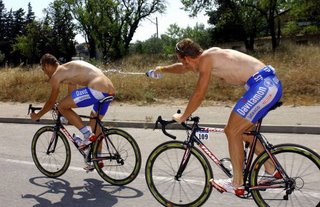

Friday, June 30, 2006
Thursday, June 29, 2006
Thought for Thursday
 Provocative Thought for this Thursday
Empathy listening gets inside another person's frame of reference. You look out through it, you see the world the way they see the world, you understand their paradigm, you understand how they feel.
Provocative Thought for this Thursday
Empathy listening gets inside another person's frame of reference. You look out through it, you see the world the way they see the world, you understand their paradigm, you understand how they feel.
Empathy is not sympathy. Sympathy is a form of agreement, a
form of jugement. And it is sometimes the more appropriate emotion and response. But people often feed on sympathy. It makes them dependent. The essence of empathetic listening is not that you agree with someone; it's that you fully, deeply, understand that person, emotionally as well as intellectually.
Workout Wednesday
The ability to get into and maintain contact with a group can save you a tremendous amount of energy. When the group surges and a gap opens, you need the power to close it; when the pace picks up toward the top of a climb, you need to be able to keep up.  Over Unders include periods above and below lactate threshold, so you develop the ability to ride steady, push, then ride steady again. Pedal for three minutes at 92 to 95 percent of your max sustainable heart rate. Then pick up the pace for two minutes. After the two minutes, back off to the initial intensity for three minutes, then surge for the final two minutes. Recovery between intervals is 15 minutes of easy spinning. Beginners should aim for two minute intervals; intermediate riders, three. Advanced riders can do three 12-minute intervals:2:00 steady /2:00 harder/2:00 steady/2:00 harder/2:00 steady/2:00 harder. Try incorperating these workouts into your plan once or twice a week in the six weeks before the big day.
Over Unders include periods above and below lactate threshold, so you develop the ability to ride steady, push, then ride steady again. Pedal for three minutes at 92 to 95 percent of your max sustainable heart rate. Then pick up the pace for two minutes. After the two minutes, back off to the initial intensity for three minutes, then surge for the final two minutes. Recovery between intervals is 15 minutes of easy spinning. Beginners should aim for two minute intervals; intermediate riders, three. Advanced riders can do three 12-minute intervals:2:00 steady /2:00 harder/2:00 steady/2:00 harder/2:00 steady/2:00 harder. Try incorperating these workouts into your plan once or twice a week in the six weeks before the big day.
 Over Unders include periods above and below lactate threshold, so you develop the ability to ride steady, push, then ride steady again. Pedal for three minutes at 92 to 95 percent of your max sustainable heart rate. Then pick up the pace for two minutes. After the two minutes, back off to the initial intensity for three minutes, then surge for the final two minutes. Recovery between intervals is 15 minutes of easy spinning. Beginners should aim for two minute intervals; intermediate riders, three. Advanced riders can do three 12-minute intervals:2:00 steady /2:00 harder/2:00 steady/2:00 harder/2:00 steady/2:00 harder. Try incorperating these workouts into your plan once or twice a week in the six weeks before the big day.
Over Unders include periods above and below lactate threshold, so you develop the ability to ride steady, push, then ride steady again. Pedal for three minutes at 92 to 95 percent of your max sustainable heart rate. Then pick up the pace for two minutes. After the two minutes, back off to the initial intensity for three minutes, then surge for the final two minutes. Recovery between intervals is 15 minutes of easy spinning. Beginners should aim for two minute intervals; intermediate riders, three. Advanced riders can do three 12-minute intervals:2:00 steady /2:00 harder/2:00 steady/2:00 harder/2:00 steady/2:00 harder. Try incorperating these workouts into your plan once or twice a week in the six weeks before the big day.
Wednesday, June 28, 2006
Tuesday, June 27, 2006
Monday, June 26, 2006
Timely Tuesday

There are some great quotes from "Daily Reflections for Highly Effective People" by Stephen R. Covey, if taken to heart will definately impact our time positively:
"Effective people are not problem-minded; they're opportunity-minded. They feed opportunities and starve problems."
"So often the problem is in the system, not in the people. If you put good people in bad systems, you get bad results. You have to water the flowers you want to grow."
 "We simply assume that the way we see things is the way they really are or the way they should be. And our attitudes and behaviors grow out of those assumptions."
"We simply assume that the way we see things is the way they really are or the way they should be. And our attitudes and behaviors grow out of those assumptions."
"The power to make and keep commitments to ourselves is the essence of developing the basic habits of effectiveness."
 "We simply assume that the way we see things is the way they really are or the way they should be. And our attitudes and behaviors grow out of those assumptions."
"We simply assume that the way we see things is the way they really are or the way they should be. And our attitudes and behaviors grow out of those assumptions."
"We must look at the lens through which we see the world, as well as at the world we see, and understand that the lens itself shapes how we interpret the world."
Sunday, June 25, 2006
Money Monday
If you go to Starbucks every morning before work and get a latte which cost about $3.50. You would spend about $840 annually. If you make your coffee at home every morning it may cost you about $.25 a cup. So you would spend about $60 annually. This is a cost savings of $839.75 that you could put into your savings and draw interest.
If you eat out for lunch every day at work you may spend from $5 to $7 at a quickservice restaurants. For full service you may pay $15 or more with tip. That is about $1,200 to $1,680 anually for quickservice and $3,750 or more for full service.
If you bring your lunch to work you may spend $2 to $3. Which is $480 to $720 anually. A cost savings of $720 to $960 from quick service and $3,270 or more from full service. This money could also be put into a savings drawing interest. You could also plan healthier meals.
Food for thought with your money!
Saturday, June 24, 2006
Friday, June 23, 2006
Wednesday, June 21, 2006
Thought for Thursday
Workout Wednesday






YOGA
Yoga is a great thing to incorperate into your cardio or weight training. Here are some benifits that Yogo gives you.
Stress Relief- Yoga reduces the physical effects of stress on the body. By encouraging relaxation, yoga helps to lower the levels of the stress hormone cortisol. Related benefits include lowering blood pressure and heart rate, improving digestion and boosting the immune system as well as easing symptoms of conditions such anxiety, depression, fatigue, asthma and insomnia.
Pain Relief-Yoga can ease pain. Studies have demonstrated that practicing yoga asanas(postures), meditation or a combination of the two, reduced pain for people with conditions such as cancer, multiple sclerosis, auto-immune diseases and hypertension as well as arthritis, back and neck pain, carpal tunnel syndrome, fibromyalgia, eczema, irritable bowel syndrome and other chronic conditions. Some practitioners report that even emotional pain can be eased through the practice of yoga.
Better Breathing-Yoga teaches people to take slower, deeper breaths. This helps to improve lung function, trigger the body's relaxation response and increase the amount of oxygen available to the body.
Flexibility-Yoga helps to improve flexibility and mobility, increasing range of movement and reducing aches and pains. Many people can't touch their toes during their first yoga class. Practitioners begin to use the correct muscles to make the movement and, over time, the ligaments, tendons, and muscles gradually lengthen and elasticity is increased. These gradual changes can mean that more and more poses are possible.
Weight Management-Yoga can aid weight control efforts by reducing the cortisol levels as well as by burning excess calories and reducing stress. Yoga also encourages healthy eating habits and provides a heightened sense of well being and self-esteem.
Increases Strength-Yoga helps to improve Yoga asanas (posture) use every muscle in the body, helping to increase strength literally from head to toe. And, while the posture practiced in yoga strengthen the body, they also provide an additional benefit of helping to relieve muscular tension.circulation and, as a result of various poses, more efficiently moves oxygenated blood to the body's cells.
Cardiovascular Conditioning-Even gentle yoga practices can provide cardiovascular benefits by lowering resting heart rate, increasing endurance and improving oxygen uptake during excercise.
Better Body Alignment-Yoga helps to improve body alignment, resulting in better posture and helping to relieve back, neck, joint and muscle problems.
Focus on the Present-Yoga helps us to focus on the present, to become more aware and to help create mind body health. It opens the way to improved coordination, reaction time and memory.
Monday, June 19, 2006
Timely Tuesday
 Where Do You Get Alternative Plans?
Where Do You Get Alternative Plans?
Someone has aptly noted that the cleanliness of
theory is no match for the mess of reality. If we start doing our planning within the context of where we are right now, we may soon give up.
Somehow we have to take our mind away from the negative
situation at hand and draw from both our experience and the experiences of others all of the different ideas that may be there. If you're stuck in some quicksand, there is little use in analyzing its consistency. Better to look for a nearby branch!
For the moment, we need to ignore the problem of the
present and consider the possibilities of the future. There are a number of ways of doing this:
The Random List. Some people prefer to sit down with a blank sheet and just list out all the ideas that come to them in any random fashion. Then they go back and try to order these in some logical way, eliminating the ones that won't work.
The Slip Technique.Others find that the slip technique works well. On a batch of three-by-five cards or-less expensive!-slips of paper, write down every idea you have. Pay no attention to logic or what has gone before. Later on, spread these writen ideas out on a table and arrange them in ways that will work into a usable plan.
This process has the double benefit of showing gaps that can prompt us to identify new ways of filling in missing steps. This approach also works very well as a brainstorming technique with other people.
You should utilize the one that best works for you. Which plan do you think the US military would use?
Sunday, June 18, 2006
Money Monday
 On a previous Money Monday we said in order to be middle class you should save 10% of your total gross income. You should take your savings and investment dollars off the top of your paycheck before you start spending. If your cash flow shows you need every dime, hope still exist. Aim to save 10% of your gross. If this is too much, start with a smaller percentage and increase the amount as quickly as you can.
On a previous Money Monday we said in order to be middle class you should save 10% of your total gross income. You should take your savings and investment dollars off the top of your paycheck before you start spending. If your cash flow shows you need every dime, hope still exist. Aim to save 10% of your gross. If this is too much, start with a smaller percentage and increase the amount as quickly as you can.
Three "pockets" could be holding extra money for you.
Tax Savings- Did you get a large refund from last year's tax return? If you did, you are having too much withheld. You can start investing or saving that refund money each month and benefit from the earnings instead of giving Uncle Sam free use of your money.

Expense Reductions-If you are about to pay off a loan or credit card this expense reduction can have the effect of raising your income. The increased cash flow becomes an excellent source for new savings. Cut or reduce your finance charges and use this same money to fill your own pocket.
 More Income-If tax savings and cutting expenses won't help, then you need to look at bringing in more money. You must be creative and optimistic about finding ways to get some extra money.
More Income-If tax savings and cutting expenses won't help, then you need to look at bringing in more money. You must be creative and optimistic about finding ways to get some extra money.
Subscribe to:
Comments (Atom)





































